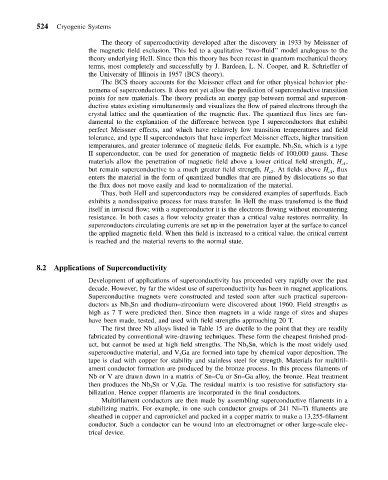Page 535 - Mechanical Engineers' Handbook (Volume 4)
P. 535
524 Cryogenic Systems
The theory of supercoductivity developed after the discovery in 1933 by Meissner of
the magnetic field exclusion. This led to a qualitative ‘‘two-fluid’’ model analogous to the
theory underlying HeII. Since then this theory has been recast in quantum mechanical theory
terms, most completely and successfully by J. Bardeen, L. N. Cooper, and R. Schrieffer of
the University of Illinois in 1957 (BCS theory).
The BCS theory accounts for the Meissner effect and for other physical behavior phe-
nomena of superconductors. It does not yet allow the prediction of superconductive transition
points for new materials. The theory predicts an energy gap between normal and supercon-
ductive states existing simultaneously and visualizes the flow of paired electrons through the
crystal lattice and the quantization of the magnetic flux. The quantized flux lines are fun-
damental to the explanation of the difference between type I superconductors that exhibit
perfect Meissner effects, and which have relatively low transition temperatures and field
tolerance, and type II superconductors that have imperfect Meissner effects, higher transition
temperatures, and greater tolerance of magnetic fields. For example, Nb Sn, which is a type
3
II superconductor, can be used for generation of magnetic fields of 100,000 gauss. These
materials allow the penetration of magnetic field above a lower critical field strength, H ,
c1
but remain superconductive to a much greater field strength, H . At fields above H , flux
c1
c2
enters the material in the form of quantized bundles that are pinned by dislocations so that
the flux does not move easily and lead to normalization of the material.
Thus, both HeII and superconductors may be considered examples of superfluids. Each
exhibits a nondissipative process for mass transfer. In HeII the mass transferred is the fluid
itself in inviscid flow; with a superconductor it is the electrons flowing without encountering
resistance. In both cases a flow velocity greater than a critical value restores normality. In
superconductors circulating currents are set up in the penetration layer at the surface to cancel
the applied magnetic field. When this field is increased to a critical value, the critical current
is reached and the material reverts to the normal state.
8.2 Applications of Superconductivity
Development of applications of superconductivity has proceeded very rapidly over the past
decade. However, by far the widest use of superconductivity has been in magnet applications.
Superconductive magnets were constructed and tested soon after such practical supercon-
Sn and rhodium–zirconium were discovered about 1960. Field strengths as
ductors as Nb 3
high as 7 T were predicted then. Since then magnets in a wide range of sizes and shapes
have been made, tested, and used with field strengths approaching 20 T.
The first three Nb alloys listed in Table 15 are ductile to the point that they are readily
fabricated by conventional wire-drawing techniques. These form the cheapest finished prod-
Sn, which is the most widely used
uct, but cannot be used at high field strengths. The Nb 3
superconductive material, and V Ga are formed into tape by chemical vapor deposition. The
3
tape is clad with copper for stability and stainless steel for strength. Materials for multifil-
ament conductor formation are produced by the bronze process. In this process filaments of
Nb or V are drawn down in a matrix of Sn–Cu or Sn–Ga alloy, the bronze. Heat treatment
Sn or V Ga. The residual matrix is too resistive for satisfactory sta-
then produces the Nb 3
3
bilization. Hence copper filaments are incorporated in the final conductors.
Multifilament conductors are then made by assembling superconductive filaments in a
stabilizing matrix. For example, in one such conductor groups of 241 Ni–Ti filaments are
sheathed in copper and cupronickel and packed in a copper matrix to make a 13,255-filament
conductor. Such a conductor can be wound into an electromagnet or other large-scale elec-
trical device.

